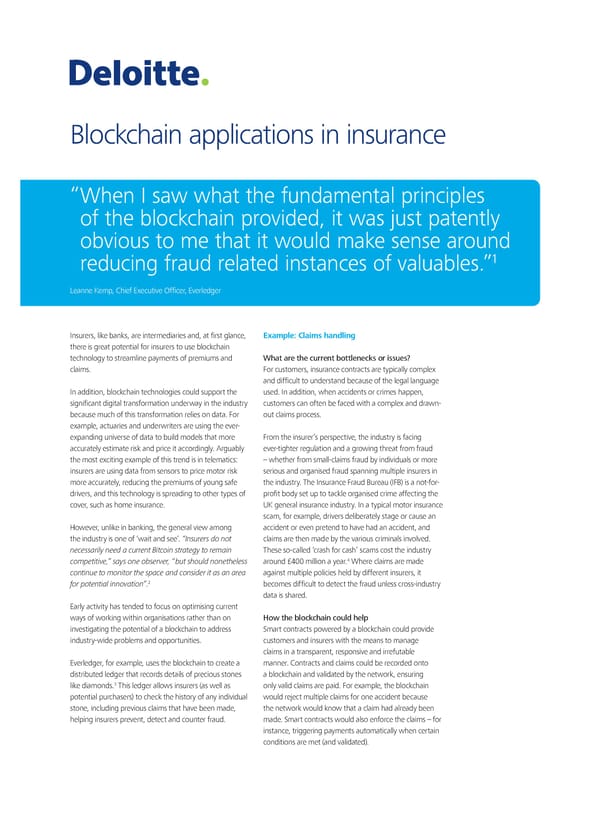To start a new section, hold down the apple+shift keys and click Document Variables to release this object and type the section title in the box below. Document Title Template Document Subtitle Subtitle Blockchain applications in insurance “ When I saw what the fundamental principles of the blockchain provided, it was just patently obvious to me that it would make sense around 1 reducing fraud related instances of valuables.” Leanne Kemp, Chief Executive Officer, Everledger Insurers, like banks, are intermediaries and, at first glance, Example: Claims handling there is great potential for insurers to use blockchain technology to streamline payments of premiums and What are the current bottlenecks or issues? claims. For customers, insurance contracts are typically complex and difficult to understand because of the legal language In addition, blockchain technologies could support the used. In addition, when accidents or crimes happen, significant digital transformation underway in the industry customers can often be faced with a complex and drawn- because much of this transformation relies on data. For out claims process. example, actuaries and underwriters are using the ever- expanding universe of data to build models that more From the insurer’s perspective, the industry is facing accurately estimate risk and price it accordingly. Arguably ever-tighter regulation and a growing threat from fraud the most exciting example of this trend is in telematics: – whether from small-claims fraud by individuals or more insurers are using data from sensors to price motor risk serious and organised fraud spanning multiple insurers in more accurately, reducing the premiums of young safe the industry. The Insurance Fraud Bureau (IFB) is a not-for- drivers, and this technology is spreading to other types of profit body set up to tackle organised crime affecting the cover, such as home insurance. UK general insurance industry. In a typical motor insurance scam, for example, drivers deliberately stage or cause an However, unlike in banking, the general view among accident or even pretend to have had an accident, and the industry is one of ‘wait and see’. “Insurers do not claims are then made by the various criminals involved. necessarily need a current Bitcoin strategy to remain These so-called ‘crash for cash’ scams cost the industry 4 competitive,” says one observer, “but should nonetheless around £400 million a year. Where claims are made continue to monitor the space and consider it as an area against multiple policies held by different insurers, it 2 for potential innovation”. becomes difficult to detect the fraud unless cross-industry data is shared. Early activity has tended to focus on optimising current ways of working within organisations rather than on How the blockchain could help investigating the potential of a blockchain to address Smart contracts powered by a blockchain could provide industry-wide problems and opportunities. customers and insurers with the means to manage claims in a transparent, responsive and irrefutable Everledger, for example, uses the blockchain to create a manner. Contracts and claims could be recorded onto distributed ledger that records details of precious stones a blockchain and validated by the network, ensuring 3 like diamonds. This ledger allows insurers (as well as only valid claims are paid. For example, the blockchain potential purchasers) to check the history of any individual would reject multiple claims for one accident because stone, including previous claims that have been made, the network would know that a claim had already been helping insurers prevent, detect and counter fraud. made. Smart contracts would also enforce the claims – for instance, triggering payments automatically when certain conditions are met (and validated). J3975_BlockchainInsert.indd 3 15/01/2016 17:00
 Blockchains: Enigma. Paradox. Opportunity. Page 21 Page 23
Blockchains: Enigma. Paradox. Opportunity. Page 21 Page 23